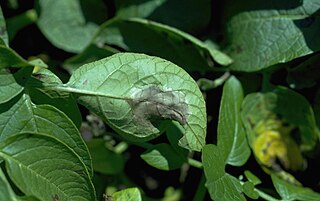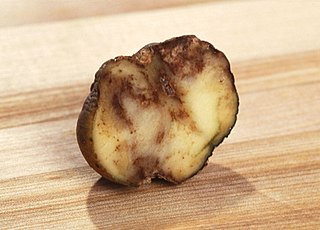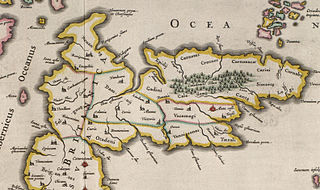
The Great Famine, also known as the Great Hunger, the Famine and the Irish Potato Famine, was a period of starvation and disease in Ireland lasting from 1845 to 1852 that constituted a historical social crisis and subsequently had a major impact on Irish society and history as a whole. The most severely affected areas were in the western and southern parts of Ireland—where the Irish language was dominant—and hence the period was contemporaneously known in Irish as an Drochshaol, which literally translates to "the bad life" and loosely translates to "the hard times". The worst year of the famine was 1847, which became known as "Black '47". During the Great Hunger, roughly 1 million people died and more than 1 million more fled the country, causing the country's population to fall by 20–25% between 1841 and 1871. Between 1845 and 1855, at least 2.1 million people left Ireland, primarily on packet ships but also on steamboats and barques—one of the greatest exoduses from a single island in history.

The Highlands is a historical region of Scotland. Culturally, the Highlands and the Lowlands diverged from the Late Middle Ages into the modern period, when Lowland Scots language replaced Scottish Gaelic throughout most of the Lowlands. The term is also used for the area north and west of the Highland Boundary Fault, although the exact boundaries are not clearly defined, particularly to the east. The Great Glen divides the Grampian Mountains to the southeast from the Northwest Highlands. The Scottish Gaelic name of A' Ghàidhealtachd literally means "the place of the Gaels" and traditionally, from a Gaelic-speaking point of view, includes both the Western Isles and the Highlands.

Phytophthora infestans is an oomycete or water mold, a fungus-like microorganism that causes the serious potato and tomato disease known as late blight or potato blight. Early blight, caused by Alternaria solani, is also often called "potato blight". Late blight was a major culprit in the 1840s European, the 1845–1852 Irish, and the 1846 Highland potato famines. The organism can also infect some other members of the Solanaceae. The pathogen is favored by moist, cool environments: sporulation is optimal at 12–18 °C (54–64 °F) in water-saturated or nearly saturated environments, and zoospore production is favored at temperatures below 15 °C (59 °F). Lesion growth rates are typically optimal at a slightly warmer temperature range of 20 to 24 °C.
Blight refers to a specific symptom affecting plants in response to infection by a pathogenic organism.

A Scottish clan is a kinship group among the Scottish people. Clans give a sense of shared heritage and descent to members, and in modern times have an official structure recognised by the Court of the Lord Lyon, which regulates Scottish heraldry and coats of arms. Most clans have their own tartan patterns, usually dating from the 19th century, which members may incorporate into kilts or other clothing.

The Agricultural Revolution in Scotland was a series of changes in agricultural practice that began in the 17th century and continued in the 19th century. They began with the improvement of Scottish Lowlands farmland and the beginning of a transformation of Scottish agriculture from one of the least modernised systems to what was to become the most modern and productive system in Europe. The traditional system of agriculture in Scotland generally used the runrig system of management, which had possibly originated in the Late Middle Ages. The basic pre-improvement farming unit was the baile and the fermetoun. In each, a small number of families worked open-field arable and shared grazing. Whilst run rig varied in its detail from place to place, the common defining detail was the sharing out by lot on a regular basis of individual parts ("rigs") of the arable land so that families had intermixed plots in different parts of the field.
Potato famine may refer to:

Sir Charles Edward Trevelyan, 1st Baronet, was a British civil servant and colonial administrator. As a young man, he worked with the colonial government in Calcutta, India. He returned to Britain and took up the post of Assistant Secretary to the Treasury. During this time he was responsible for facilitating the government's response to the Great Famine in Ireland. In the late 1850s and 1860s he served there in senior-level appointments. Trevelyan was instrumental in the process of reforming the British Civil Service in the 1850s.

Crofting is a form of land tenure and small-scale food production particular to the Scottish Highlands, the islands of Scotland, and formerly on the Isle of Man. Within the 19th-century townships, individual crofts were established on the better land, and a large area of poorer-quality hill ground was shared by all the crofters of the township for grazing of their livestock. In the 21st century, crofting is found predominantly in the rural Western and Northern Isles and in the coastal fringes of the western and northern Scottish mainland.

The Highland Potato Famine was a period of 19th-century Highland and Scottish history over which the agricultural communities of the Hebrides and the western Scottish Highlands saw their potato crop repeatedly devastated by potato blight. It was part of the wider food crisis facing Northern Europe caused by potato blight during the mid-1840s, whose most famous manifestation is the Great Irish Famine, but compared with its Irish counterpart, it was much less extensive and took many fewer lives as prompt and major charitable efforts by the rest of the United Kingdom ensured relatively little starvation.

Cotter, cottier, cottar, Kosatter or Kötter is the German or Scots term for a peasant farmer. Cotters occupied cottages and cultivated small land lots. The word cotter is often employed to translate the cotarius recorded in the Domesday Book, a social class whose exact status has been the subject of some discussion among historians, and is still a matter of doubt. According to Domesday, the cotarii were comparatively few, numbering fewer than seven thousand people. They were scattered unevenly throughout England, located principally in the counties of Southern England. They either cultivated a small plot of land or worked on the holdings of the villani. Like the villani, among whom they were frequently classed, their economic condition may be described as free in relation to everyone except their lord.

The chronology of the Great Famine documents a period of Irish history between 29 November 1845 and 1852 during which time the population of Ireland was reduced by 20 to 25 percent. The proximate cause was famine resulting from a potato disease commonly known as late blight. Although blight ravaged potato crops throughout Europe during the 1840s, the impact and human cost in Ireland – where a third of the population was entirely dependent on the potato for food but which also produced an abundance of other food – was exacerbated by a host of political, social and economic factors which remain the subject of historical debate.

The Highland Clearances were the forced evictions of a significant number of tenants in the Scottish Highlands and Islands, mostly in two phases from 1750 to 1860.

Walter Frederick Campbell of Shawfield (1798–1855), was a Scottish politician. He served as the MP for Argyllshire, 1822–1832 and 1835–1841.

The demographic history of Scotland includes all aspects of population history in what is now Scotland. The earliest surviving archaeological evidence of human settlement is of Mesolithic hunter-gatherer encampments. These suggest a highly mobile boat-using people, probably with a very low density of population. Neolithic farming brought permanent settlements dating from 3500 BC, and greater concentrations of population. Evidence of hillforts and other buildings suggest a growing settled population. Changes in the scale of woodland indicates that the Roman invasions from the first century AD had a negative impact on the native population.
Famines in Austrian Galicia were a common occurrence, particularly in the mid to late 19th century, as Galicia became heavily overpopulated. Triggered primarily by natural disasters such as floods and blights, famines, compounded by overpopulation, led to starvation, widespread malnutrition, epidemics, poverty, an average of 50,000 deaths a year, and from the 1870s to the beginning of World War I, emigration.

The Seven Ill Years, also known as the Seven Lean Years, is the term used for a period of widespread and prolonged famine in Scotland during the 1690s, named after the biblical famine in Egypt predicted by Joseph in the Book of Genesis. Estimates suggest between 5 and 15% of the total Scottish population died of starvation, while in areas like Aberdeenshire death rates may have reached 25%. One reason the shortages of the 1690s are so well remembered is because they were the last of their kind.

The Highland and Island Emigration Society was a charitable society formed to promote and assist emigration as a solution to the Highland Potato Famine.
Sir Thomas Martin Devine is a Scottish academic and author, who specializes in the history of Scotland. He is Scotland's most celebrated historian, having been knighted and made and Officer of the Order of the British Empire for his contributions to Scottish historiography. Officer of the Order of the British Empire, and is known for his overviews of modern Scottish history. He is an advocate of the total history approach to the history of Scotland. He is professor emeritus at the University of Edinburgh, and was formerly a professor at the University of Strathclyde, the University of Aberdeen.

The islands of Newfoundland and Ireland, in addition to sharing similar northern latitudes and facing each other across the Atlantic Ocean, also had in common, during the middle of the 19th century, a heavy dependence on a single agricultural crop, the potato--a dependence that allowed the same blight that precipitated the Great Famine in Ireland to wreak havoc on this former British colony as well. Though acute, and the source of great suffering, the famine in Newfoundland lasted for fewer years than its Irish contemporary, which extended from 1845 to 1849. Beginning a year later, in 1846, it ended with the return to prosperity of the local fisheries in the spring and summer of 1848.
















